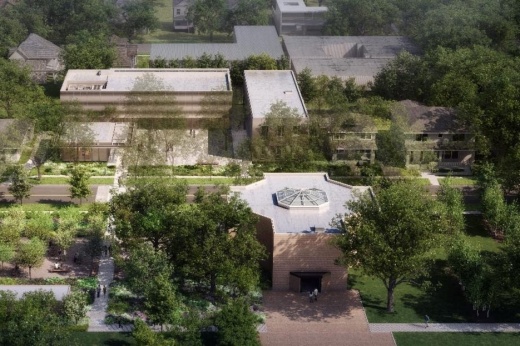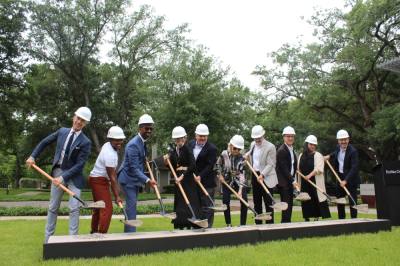Chapel officials gathered April 17 to break ground on the second phase of its $42 million Opening Spaces expansion and restoration project that will bring a new meditation garden, archives room, birch grove and other gathering spaces to the site.
What happened
Since opening in 1971, the Rothko Chapel has sought to serve as a hub "for spiritual growth and dialogue that illuminate our shared humanity and inspire action leading to a world in which all are treated with dignity and respect," according to its mission statement. It can be found 3900 Yupon St., Houston.
Discussions over the Opening Spaces project among the chapel's board go back 20 years, Executive Director David Leslie said at the April 17 event, as officials tried to prepare for the next 50 years of serving the Houston community in an area that was becoming more and more dense with each passing year.
One of the key focuses of the campaign can be found in its name: creating more physical space for visitors to access, whether it be for public events, socializing or quiet contemplation.
Digging in
The Rothko Chapel campus covers both sides of Sul Ross Street west of Yupon. It exists within one of Houston's major cultural destinations, with the Menil Collection and the Houston Center for Photography nearby.
The design of the new campus will take the existing neighborhood into account when it comes to the scale, color and layout of spaces, said Stephen Cassell, a principal with the Architecture Research Office working on the project. A new welcome plaza with an entrance from Sul Ross will be shaded by trees and used for outdoor programs while offering views into the adjacent program center, he said.
Adam Yarinsky, also an ARO principal, said the east side of the campus will be defined by a new administration and archives building, which will feature a 30-person meeting space and a climate-controlled space for researchers. The program center, on the north side, will feature a flexible room for 200 people that could be used for lectures, symposiums, banquets and workshops, he said.
Zooming in
The campus's outdoor spaces will play a critical role in how visitors experience the chapel, said Thomas Woltz, owner of the landscape architecture group Nelson Byrd Woltz. The new welcome plaza, situated between the welcome house, program center and administration building, will feature three live oak trees, he said.
“They’ll be really small at first ... but they will become a beautiful sculptural canopy for the entire plaza,” Woltz said.
A meditation garden across Sul Ross will be designed with small flowering trees, shaded seating and broad perennial beds with pale blue, deep blue and purple flowers. With the meditation garden to the west and a birch grove to the east, the chapel itself will sit in a parklike setting, Woltz said.
Woltz referenced insights from George Sexton, a specialist in how lighting is used in design, noting that it takes 10 minutes for the nuances of a painting to become fully visible once inside Rothko Chapel. The shaded garden will give visitors time for their eyes to adjust before entering the chapel, Woltz said.
“So this garden experience prepares us for what is to come," he said. "I love this idea that the landscape prepares the mind and body for the experience of art.”
What it means
The expansion will also allow the chapel to offer more space for the programming that its known for, which has included discussions of art, social justice and social issues, Leslie said. Officials hope it will open up more partnership opportunities with nonprofits and community organizations, while also allowing for more Rothko-hosted events, such as community fundraises and gatherings.
The cost
Phase 2 of the expansion will cost roughly $23 million, more than $7 million of which has been raised so far, officials said, including from national and international donors.
Including what was raised for Phase 1, Leslie said the campaign has raised more than $27 million so far in total.
The Elkins Foundation is among the recent donors, contributing $200,000 in February.
What's next
Within the next 10 days, work will take place to move an existing house on the campus one plot to the east to make room for the next administration and archives building, Leslie said. Construction will likely start around late May on that building, he said.
Once the admin building is open and staff can move in, two other bungalows on the site will also need to be relocated so the garden can be built.
The timing of work on the new program building will depend on fundraising, with Leslie estimating that another $8 million-$10 million needs to be raised before work starts. The goal for completion of Phase 2 is by the end of 2026, he said.
Quote of note
"A couple of things have been extraordinary, and first of all has been the level of support and interest in this project," Leslie said. "This whole process has really expanded people’s understanding of what the chapel’s about in this city."






